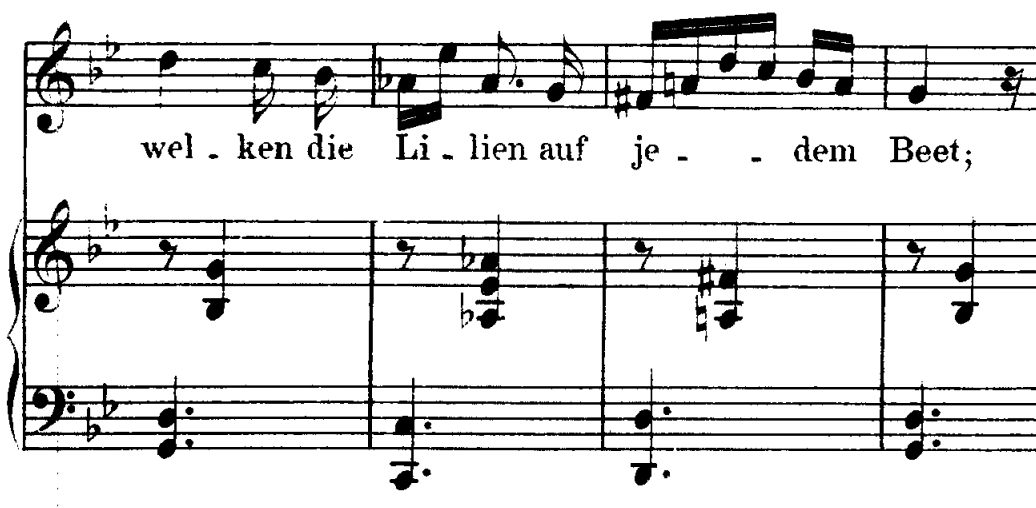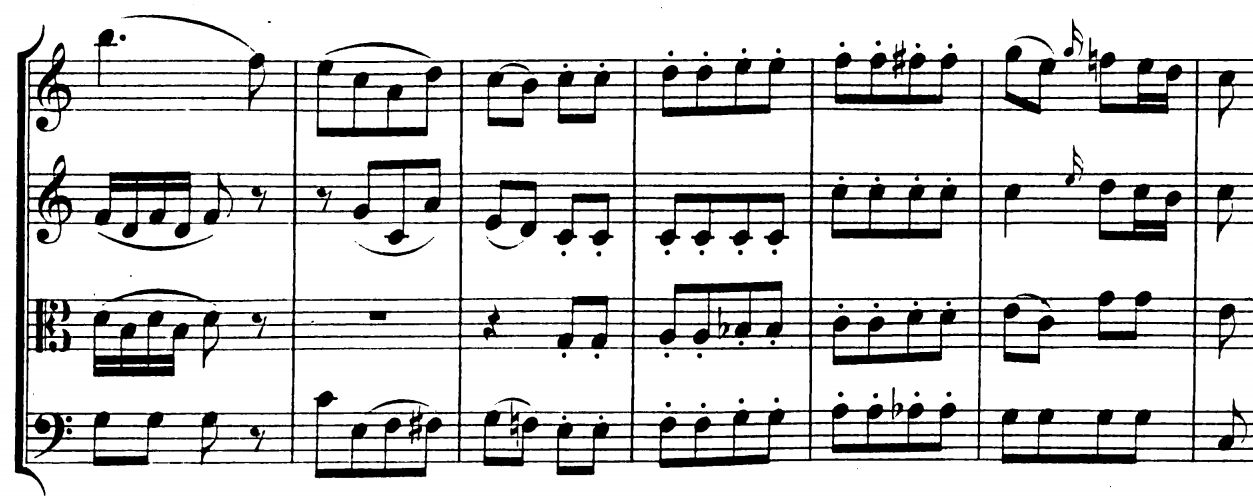Neapolitan chord
The Neapolitan chord contains lowered scale-degree 2, along with scale-degree 4, and lowered scale-degree 6: ra, fa, and le. It is a major triad, and it usually appears with fa in the bass (first-inversion), which is also doubled in a four-voice texture.
In a Roman numeral analysis, N. (or N.6) substitutes for a Roman numeral (that is, it is not labeled a flat-II chord in classical music). As a chromatically altered subdominant chord, it always expresses subominant function (S).
In a functional bass analysis, N. is placed below the functional designation of [S4].
Several prominent Neapolitan chords occur in “Der Müller und der Bach” from Schubert’s song cycle, Die schöne Müllerin (song no. 19). On the score below (mm. 7–10 of the song), the tonic triad (G minor) is followed by a Neapolitan, then a dominant-seventh chord, and then tonic: T – S – D – T.

Augmented-sixth chords
Augmented-sixth chords are so named because of the augmented sixth that occurs between le and fi, two scale-degrees that are present in every augmented-sixth chord. The other pitch(es) in the chord determine which kind of augmented-sixth chord is present.
Italian augmented-sixth chord
The Italian augmented-sixth chord is the simplest augmented-sixth chord, with only three members: le, do, and fi. Le is typically the bass note, and in a four-voice texture, do is typically the pitch that is doubled. (Keep in mind that you do not double the bass in a chord of the sixth, nor a chromatically altered tone such as fi. Thus, do remains as the only tone that can be doubled in strict style, and this doubling typically carries into freer styles, as well.)
In a Roman numeral analysis, It. replaces a Roman numeral. The figured bass is a simple slashed “6.” It expresses subdominant function S).
When le occurs in the bass, the functional-bass designation is [S6]. Under that functional bass symbol, we also label the chord It.
The following example is from Beethoven’s Bagatelle, Op. 119, No. 1, mm. 1–4. In m. 3, the Italian augmented-sixth chord falls on beat 3, immediately before the dominant chord.

French augmented-sixth chord
The French augmented-sixth chord has four members: le, do, re, and fi. As in the Italian sixth, le is typically the bass note.
In a Roman numeral analysis, Fr. replaces a Roman numeral. The figured bass is a slashed “6” with a “4” and a “3.” It expresses subdominant function S).
When le occurs in the bass, the functional-bass designation is [S6]. Under that functional bass symbol, we also label the chord Fr.
The following example is from Mozart’s String Quartet, “Dissonance,” K. 465, iv., mm. 10–16. The French augmented-sixth chord occurs on beat 2 of m. 14. In this passage, a “milder” subdominant chord (IV6) progresses to the more intense French sixth, which progresses into the cadential 6/4 before the final V–I.

German augmented-sixth chord
The German augmented-sixth chord has four members: le, do, me, and fi. As in the other augmented sixth chords, le is typically the bass note.
In a Roman numeral analysis, Ger. replaces a Roman numeral. The figured bass is a slashed “6” with a “5.” It expresses subdominant function S).
When le occurs in the bass, the functional-bass designation is [S6]. Under that functional bass symbol, we also label the chord Ger.
The German sixth is almost always used in minor and followed by a cadential 6/4 chord, with me and do carrying over into the cadential 6/4.
In Beethoven’s Piano Sonata in E Major, Op. 109, iii., a German augmented-sixth chord occurs on the last beat of m. 7 and carries over into m. 8 before releasing tension into the half cadence at the end of m. 8.

Swiss augmented-sixth chord
The Swiss augmented-sixth chord has four members: le, do, ri, and fi. This chord is named “Swiss” because it sounds German but is spelled like the French. (ri in place of me) (Switzerland has a mixture of German-, French-, Italian-, and Romansch-based languages, with German and French being the largest.) Le is typically the bass note.
In a Roman numeral analysis, Sw. replaces a Roman numeral. The figured bass is a slashed “6” with a slashed “4” and a “3.” It expresses subdominant function S).
When le occurs in the bass, the functional-bass designation is [S6]. Under that functional bass symbol, we also label the chord Sw.
Like the German sixth, the Swiss augmented-sixth is almost always followed by a cadential 6/4 chord. However, the Swiss chord tends to appear in major keys, with ri proceeding to mi and do carrying over into the cadential 6/4.
Anthology Examples
Here are list of moments in the OpenScore LiederCorpus that expert (human) analysts have viewed in terms of the chords we're discussing. The tables give the composer, collection, song, measure, Roman number (figure) and key.
Neapolitan Sixth Chords
[table id=33 /]
Augmented Sixth chords
[table id=32 /]
